Abstract
This paper presents the case study of provisions of frequency containment reserve (FCR) with a battery electric storage system (BESS). The aim of the case study is the evaluation of the technical possibility to provide FCR in Latvian power systems after all Baltic power systems will synchronize with the Continental Europe Synchronous Area (CESA). To simulate the dynamics of BESS capacity and its state of charge (SOC), authors have developed an algorithm and mathematical model (it can be realized in different calculation programs). The case study calculations verified the model. The algorithm is conditionally divided into two parts—FCR provision and SOC recovery–which in turn is divided into three possible models of BESS state of charge recovery options: (1) overfulfillment—exceeding the specified FCR amount, (2) deadband utilization, and (3) BESS charging or discharging through scheduled transactions in intraday power market. The modelling was performed using historic frequency data of Latvian and French power systems. The case study of BESS with charging capacity of 12 MW and stored energy volume of 7 MWh for provision of determined FCR for Latvian power system was considered. The obtained results from the simulation were used in the separate model to evaluate economic feasibility of BESS for FCR.
1. Introduction
Historically, power systems of Estonia, Latvia, and Lithuania were operated in parallel with power systems of Russia and Belarus based on the so-called BRELL agreement (abbreviation of Belarus, Russia, Estonia, Latvia, Lithuania) [1,2]. Frequency control was centralised and provided by Russian United Power System (UPS). Transmission system operators (TSOs) in BRELL were responsible for minimize frequency mitigation by maintaining power generation and demanding equilibrium. According to the existing Network Codes in Baltic States, frequency must be maintained between 49.95 Hz to 50.05 Hz.
In 2018, a political decision was made on the synchronization of the power system of the Baltic States with the continental European electricity system, and the disconnection (desynchronization) from the electricity systems of Russia and Belarus. As desynchronization from the BRELL and synchronisation to the Continental Europe Synchronous Area (CESA) is an approved goal for Baltic States, it will be crucial to maintain the frequency stable for each TSO of the Baltic States [2,3]. It is expected to be a rather difficult task, so the solution for this problem is complex. While connected to BRELL the frequency control is centralised. After synchronisation with CESA, each of the Baltic States’ TSOs must be able to maintain power equilibrium and frequency control—activation of frequency containment reserves (FCR) immediately after a difference in the balance between generation and demand. Both the construction of new interconnections and the reconstruction of existing ones, as well as the strengthening of the existing network, network management, and control systems in each country, require large-scale investments. At the same time, the decarbonization goals are highly responsible for large renewable power penetration in the power system, thus decreasing conventional generation; this could affect the power equilibrium and loss of system inertia [4,5,6,7]. There are several methods for system inertia control. The research conducted by the Institute of Power Engineering in Riga Technical University concludes that synchronous condensers in AC power systems can respond with active power injection during a loss of generation, and–in combination with novel load shedding method–show promising results for further investigation, thus opening new methods for system stability control [1].
To carry out this ambitious plan, the Baltic States TSOs have signed the “Memorandum of understanding on development of the Baltic load-frequency control block” [3,8]. The memorandum explains a high-level concept for balance management, FCR technical requirements, concept of FCR prequalification process, and FCR dimensioning rules. The situation in Baltic power system management will also change with the introduction of new Grid Codes and Guidelines for new pan-European platforms or markets for ancillary electricity services (MARI (go-live planned for 2022), PICASSO, TERRE), according to Regulation (EU) 2017/2195 of November 2017. Therefore, after the synchronization with CESA, there will be an opportunity to offer new ancillary services in the Baltic power market including active power reserves for frequency control.
The main contribution of this paper is the creation of an algorithm that can be applied to evaluate the technical possibility of provision of frequency containment reserve (FCR) with the battery electric storage system (BESS). The research is conducted as a case study to prove the suggested methods’ viability in specific circumstances in the Latvian power system.
The European Commission Regulation EU 2017/1485 on guidelines for the operation of the electricity transmission system, and the European Commission Regulation (EU) 2017/2195, establishing electricity-balancing guidelines provided for four-level frequency regulation processes or platforms. The platforms are dedicated to frequency containment reserves, automatic and manual frequency restoration reserves (aFRR/mFRR), and replacement reserves (RR). All of them (see Table 1) are introduced into the system in a certain chronology after the occurrence of active power imbalance, as shown in Figure 1.

Table 1.
Active power reserves in the Continental Europe Synchronous Area.
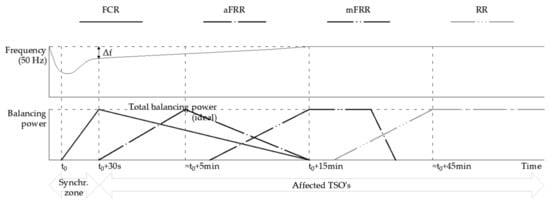
Figure 1.
Chronology of frequency control process [9].
The amount of FCR is determined annually according to the amount of generation and consumption in the synchronous zone. The total amount of FCR, aFRR, and mFRR must be equal to the largest possible cut-off unit in the Baltics (700 MW in 2025). The distribution of FCR, aFRR, and mFRR among the Baltic States calculated in 2020 is given in Table 2. As can be seen, the estimated amount of FCR for Baltic power system is ±30 MW. The estimated amount of aFFR in the Baltics in 2025 will be 100 MW (the distribution is based on the current imbalance in the Baltic States). Manually activated FRR is determined as the remaining amount of the total amount of FRR; in 2025, it will be 600 MW in the Baltics.

Table 2.
Active power reserve volumes in Baltic power systems calculated in 2020 after synchronization with CESA [10].
Recently, the European Green Deal and decarbonisation goals of energy systems have led to a growing interest in energy storage systems (ESS). ESS are a versatile tool with different technical characteristics that can provide many options of application, such as services to support generation, TSO’s or distribution system operator’s infrastructure, customer energy management, and ancillary services [11,12].
For the determined Latvian TSO’s reserve volumes, lithium-ion battery ESS (BESS) is expected to be the most suitable option. The main advantages of lithium-ion batteries in electricity system applications compared to other battery technologies are fast response time, high capacity, and long life in partial cycles. In addition, lithium-ion batteries have the potential for different power/capacity combinations. Nevertheless, the energy capacity of all batteries is limited, which limits the maximum power delivery time. Therefore, lithium-ion batteries are best suited for FCR applications characterized by short-term power supply [13,14]. The possibility to install BESS in almost any place gives this technology a noticeable advantage. Thus, in this research, other ESS technologies are not considered.
The idea to use BESS for FCR has been discussed for a while. Other research reviewed on this topic has concluded that BESS can provide needed response speed to provide FCR. Regulation capability and ancillary services’ price have vast influence on BESS economics and operation. The algorithm should be tailored for specific power systems and electricity market needs. Reviewed studies have not addressed the problems Baltic TSO’s will encounter in the nearest future, thus the proposed methodology and conclusions could be used as guidelines in the decision-making process [15,16,17,18,19].
In following sections, authors propose methodology to determine the possibility to use battery systems for FCR service. The background of the mathematical model, the analyses of the frequency data from Latvian and French power systems, the assumptions on the BESS used for calculations, and the tailored algorithm are described in Section 2. In Section 3, authors review the results. To evaluate the viability and feasibility, economic assumptions and sensitivity analyses are described in Section 4. In Section 5, authors give the conclusions and proposed discussion questions of the research.
2. Methodology
To understand whether it is possible to maintain frequency stability with BESS in the power system of Latvia, the research team conducted a case study, developed a calculation model, and tested the system’s frequency containment option for previously recorded frequency deviations.
2.1. Mathematical Modeling of BESS FCR
The modelling of BESS operation for providing FCR is based on the Latvian TSO planned conditions for the implementation of ancillary services considering synchronization with the CESA until 2025 [9]. The characteristics of the planned FCR product are summarized in Table 3.

Table 3.
FCR product characteristics [9].
Some principles of the German integrated market for ancillary services have been considered as well. One of these states that all FCR bids must be symmetrical, i.e., up and down regulation must be provided [20].
The FCR provision process or so-called primary frequency control is based on a load-frequency characteristic, as shown in Figure 2. FCR is not intended to restore the frequency to a nominal value (50 Hz), but to restore the balance of generated and consumed power in the system and to keep the frequency at a stable limit. This historically has been done by automatically adjusting the output of generating units. The amount of active power required to restore this balance or prevent the further frequency increase or decrease is proportional to the system’s frequency deviation from the nominal value.
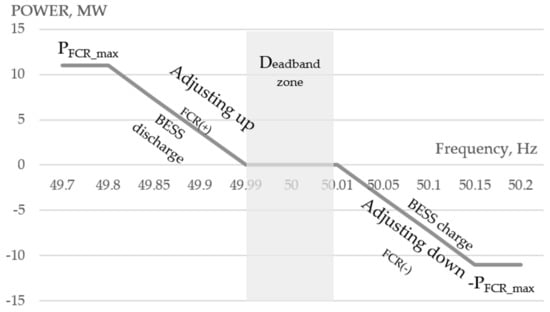
Figure 2.
Primary frequency control load-frequency curve.
According to the proportional load-frequency characteristics, the current battery power PBESS(t) for FCR provision is defined mathematically as following:
where ±PFCR(t)—actual necessary positive or negative power for FCR provision according to frequency deviation, ∆f = f − fnom—deviation of actual frequency f from the nominal frequency fnom = 50 Hz, PFCR_max—maximal FCR power defined in Table 3, and ∆fmax—maximal frequency deviation at which total prequalified FCR power should be activated. In the synchronous grid of Continental Europe, the maximum steady-state frequency deviation is ±200 mHz, at which full FCR power must be activated in 30 s. The frequency band or deadband in which FCR delivery is not required is ±10 mHz [21,22].
As the frequency deviation increases, the required active power increases linearly. If the frequency deviation is above 50 Hz, there is active power surplus in the network. This means generated active power must be reduced, or negative FCR provision (FCR (−)) is required, and vice versa—when frequency is below 50 Hz generated active power must be increased or positive FCR power (FCR (+)) is required. In the BESS case the positive FCR is provided by discharging the BESS and negative—by charging BESS. In the calculations, BESS power is assumed to be positive if BESS is charged, and negative if BESS is discharged.
In the event of the frequency deviation, the generating units that provide the FCR automatically activate them within a few seconds; therefore, primary frequency control is the fastest way to control the power system (Figure 1).
2.2. Frequency Data
Frequency data provided by the Latvian TSO for 2018 and 2019 were used in the calculations of BESS operation, as well as the calculations with French power system (RTE) data [22] for 2019 were used for comparison. Frequency measurements are summarized at 1-min intervals.
In the Latvian power system, the frequency dynamics have been similar in both analyzed years. For purpose of better perception, Figure 3 and Figure 4 show Latvian and French power system frequency deviations at 4-h and one-month periods accordingly. Figure 5 shows the frequency histogram of Latvian and French power systems. Although the primary frequency regulation is currently provided by the Russian UPS, the frequency characteristics were analysed in the context of the requirements of EU network codes and guidelines. Most of the time, the frequency was within the allowable limits from 49.99 to 50.01 Hz–61% of all cases in 2018 and 63% in 2019. Approximately 37% of the time in 2018, and 39% in 2019, the frequency was outside the normal frequency deviation limits of ±0.01 Hz–when no primary frequency control should be performed. In both years, the frequency was above 50 Hz (51%) most of the time.
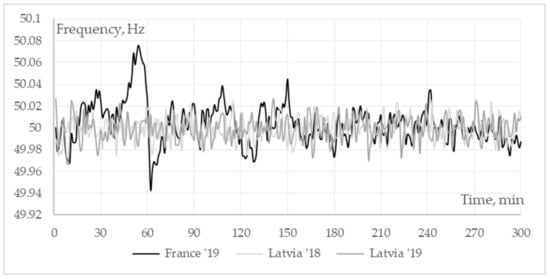
Figure 3.
Frequency changes in Latvian and French power systems during 4-h period from 00:00–04:00 in 5 February.

Figure 4.
Frequency changes in Latvian and French power systems on monthly (February) basis.
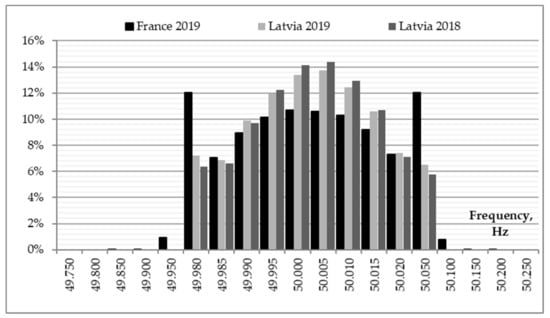
Figure 5.
Frequency histogram of Latvian and French power systems.
In contrast, the French power system, which is part of CESA, had significantly larger frequency deviations from the nominal value. The frequency was outside the permissible limits 49% of the time (Figure 3, Figure 4 and Figure 5). As the frequency data are rapidly changing, the following pictures are used to display the large difference in frequency variability and dynamics in Latvia and France. In Figure 3 the time scale is 4 h on 5 February, and Figure 4 the time scale is whole month of February 2019 (major gridlines represent one week, minor gridlines represent one day).
2.3. BESS Life Cycle and Degradation
Battery life is one of the most important factors in any BESS application, as it will greatly affect the cost-effectiveness of the project. BESS life cycle is basically evaluated according to two criteria—calendar life and cycle life. At these particular circumstances, the end-of-life criterion is considered to be a 20% reduction in capacity, which is facilitated by both processes—calendar and cycle aging. As more recycled products are becoming available for stationary cases, the BESS life could be extended up to values lower than 70% of the initial installed capacity, which could lead to better feasibility results. Battery life depends mainly on temperature, time, state of charge, and number of cycles [14]. To simplify the calculations, authors assumed that the decrease of the lithium-ion BESS capacity is linear over time and amounts to a 2% reduction from the initial nominal capacity each year. Thus, the technical life of BESS is assumed to be 10 years.
2.4. Calculation Algorithm of the BESS Model
The algorithm (Figure 6) is conditionally divided into two parts—FCR provision and SOC recovery–which in turn is divided into three parts according to the above-described SOC management options: deadband utilization, FCR overfulfillment, and scheduled market transactions.
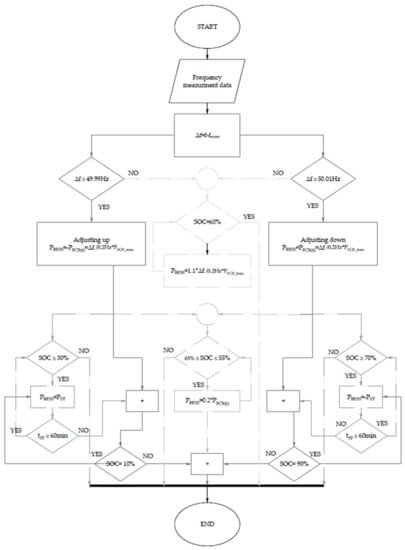
Figure 6.
Blocksheme for the BESS operation.
The BESS control provides the FCR service for the requested time, except when the upper or lower charge limit is reached (90% and 10%, respectively). When the BESS charge status reaches the specified limits, the FCR service is disabled and the batteries are charged/discharged to the SOC set point, thus restoring the FCR service.
The use of the deadband is activated as soon as the frequency change is within the specified deadband and the SOC level is outside the defined normal value (60%). Overfulfillment of the specified FCR amount, as well as planned market transactions, take place in parallel with the relevant SOC settings.
2.5. Selection of BESS Parameters and Operating Principle
The choice of BESS nominal power (PBESS_nom) is determined by the required amount of FCR for the Latvian power system after synchronization with the CESA, which is ±11 MW (see Table 2). Table 4 shows all the technical parameters selected for BESS.

Table 4.
Selected BESS parameters.
According to the requirements of the European Commission Regulation EU 2017/1485, both upward and downward FCR provision must be ensured for at least 15 min. This criterion sets the limits for the operation of BESS or the state of charge (SOC). The state of charge for the BESS is an important criterion in planning its operation. BESS manufacturers do not recommend fully discharging or recharging the Li-ion battery systems due to increased degradation of the battery cells. Instead, the maximum and minimum charge conditions that must be observed to ensure that the life cycle specified by the BESS are maintained. The developed BESS model assumes that the maximum SOC (SOCmax) is 0.9 or 90% of the nominal capacity (EBESS_nom) of the battery, while the battery can be discharged (SOCmin) up to 10% of its nominal capacity. Thus, the maximum battery depth of discharge is 80%, which determines the actual available capacity of the battery (EBESS_fact).
To ensure the previously mentioned 15-min criterion in both directions, as well as the permissible SOC levels, a minimum battery capacity is determined mathematically as follows:
where 0.5—defines half of an hour or FCR provision time of 15 min both upwards and downwards, and —is the coefficient of depth of discharge equal to 0.8.
Calculating the Equation (2) and rounding up, the battery nominal capacity of 7 MWh was determined. In addition, the BESS’s normal state of charge (SOCnorm) should be maintained close to 50% to guarantee full BESS availability for both up and down FCR regulation. The calculation assumes that a normal state of charge level is 60%.
The state of charge of the battery is calculated and the model verifies whether the SOC lies within the permitted SOC bandwidth as follows:
where —state of charge at previous time moment, —round-trip efficiency of battery storage system, —time moment of 1 min in the studied case. It is worth reminding that battery power PBESS(t) is positive when charging and negative when discharging.
The round-trip efficiency of BESS for charging and discharging processes–also considering the efficiency of the inverter and step-up transformer–is assumed to be 92% [23].
Due to the continuous operation of the BESS with insignificant periods of downtime, the overall self-discharge of the BESS is not considered in the calculations. BESS self-consumption is also not considered in the calculations.
2.6. Maintaining Normal State of Charge
While providing FCR reserves, the BESS is charged and discharged continuously. At some point–at higher frequency deviations–it may reach full charge or discharge, and at that point it will no longer be able to provide symmetric FCR service. Therefore, a BESS state of charge management strategy is required to ensure that BESS will supply FCR capacity throughout the contracted timeslices. Here, authors have considered some options to maintain normal SOC level, as practiced in the German FCR market.
The German FCR market legislation allows in certain cases to deviate from the proportional frequency regulation curve. This is especially important for BESS operators, as they can use these options to restore state of charge levels. Typically, the battery operator has three options to balance the charge level and maintain the normal operating range of the BESS during primary control operation [21,22].
First option is overfulfillment when it is allowed for battery operators to exceed the specified FCR power up to 120% of the load-frequency curve P(f), as shown in Figure 7. This option can be used to selectively charge or discharge the battery as needed.
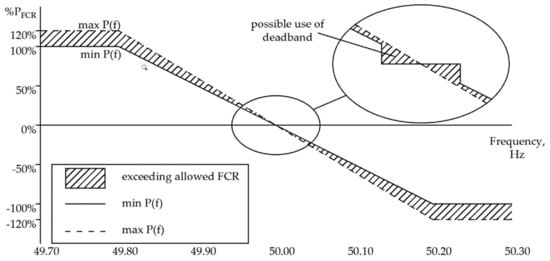
Figure 7.
Exceedance range and deadband of the specified FCR [15].
Second option is deadband utilization. BESS operators have the option of resetting the charge level in the frequency deadband, which is ±10 mHz (Figure 7). They may choose to comply with or deviate from the P(f) curve. However, the opposite control is not allowed—BESS should not be discharged when the FCR is positive, and BESS should not be charged when the FCR is negative. In this case the accuracy of the frequency measurement equipment and the control measurement must be high.
The third option is BESS charging or discharging through scheduled market transactions. This means that the balancing energy can be purchased or sold in the intraday market to restore the desired BESS charge level. It must be ensured that the net FCR supply (battery capacity minus capacity purchased/sold on-the-spot market) continues to comply with FCR regulations. When the BESS is charged or discharged with the planned energy, its operating point is changed to enable the primary control operation at the same time. The BESS operator must present the concept to the responsible TSO and notify the TSO 15 min before the change of operating point.
The intraday market is a part of the wholesale electricity market in which electricity is traded in relatively small volumes with a short delivery time. Products available on the intraday market include hourly and quarterly electricity supply contracts.
In the first and second options, the electricity consumed from the grid to recharge the battery depends on the system frequency, but the energy bought or sold on-the-spot electricity market (third option) does not depend on the system frequency and can be used to significantly adjust the SOC of BESS. On the other hand, the first and second options are free of charge, but on-the-spot market electricity must be purchased at a fixed price, which increases BESS’s operating costs, while electricity sold on-the-spot market generates additional income.
The authors use all three options simultaneously in the calculations of BESS operation to maintain the normal state of charge (Table 5). Therefore, the following characteristics were defined:
- The deadband utilization is used in the ±10 mHz frequency range.
- FCR overfulfillment starts when the state of charge decreases to 55% (SOCOF_min) or increases to 65% (SOCOF_max). When these limits are reached, the required amount of FCR is exceeded by 20%, thus speeding up BESS charging or discharging.
- Scheduled market transactions are activated at 30% state of charge level (SOCST_min) and 70% (SOCST_max), respectively. An important aspect to be considered to ensure the SOC management through the scheduled market transactions is the planned transaction capacity (PST), which should be additionally accounted for the BESS investment costs. In the calculation model, authors assume additional capacity of 1 MW for market transactions, which will be sold or purchased on the spot market for 1 h as the SOC level reaches defined limits.

Table 5.
Parameters for SOC management.
Table 5.
Parameters for SOC management.
| Planned transaction capacity | PST, MW | 1 |
| Minimum state of charge for activation of FCR overfulfillment (OF) | SOCOF_min | 0.55 |
| Maximum state of charge for activation of FCR overfulfillment (OF) | SOCOF_max | 0.65 |
| Minimum state of charge for activation of scheduled transaction (ST) for charging | SOCST_min | 0.3 |
| Maximum state of charge for activation of scheduled transaction (ST) for discharging | SOCST_max | 0.7 |
3. Results
The research team used the developed calculation algorithm to study BESS performance at three cases of frequency fluctuations in the Latvian power system in 2018 and 2019, as well as in the French power system in 2019.
Figure 8 shows the amount of FCR provided by the BESS, as well as the electricity consumed or transferred to restore the normal state of charge of the BESS using all three SOC management options (charge with + and discharge with −). In total, in the Latvian power system, BESS discharged 2100–2240 MWh to the network and consumed 2540–2660 MWh for charging accordingly in the studied year. The electricity required to renew the SOC accounted for only a small part of the total BESS electricity: 0.5% to 5% performing FCR overfulfillment and 7% to 20% using the deadband.
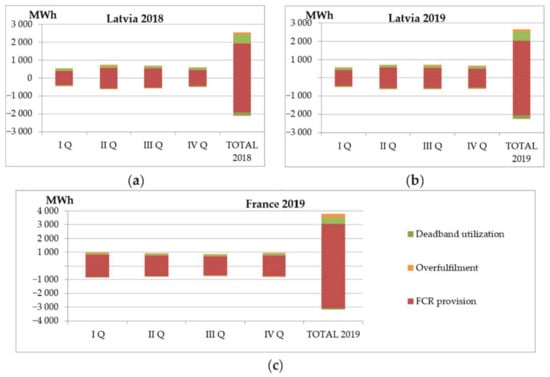
Figure 8.
BESS performance for FCR provision and SOC management: (a) in Latvia 2018, (b) in Latvia in 2019, (c) in France in 2019.
It should be noted that in the example of frequency deviations in power system of France, BESS was unable to provide the required amount of FCR with the selected parameters. In the French example, the electricity provided by the BESS in charging and discharging processes exceeded the one of Latvian example by almost 70%. Therefore, in the calculations with frequency fluctuations of French power system, the capacity required for the scheduled market transactions was increased to 2 MW. Results in Figure 8 show that in this case, BESS transferred around 3160 MWh to the network and consumed around 3800 MWh of electricity for charging.
Figure 9 shows the amount of electricity required for the renewal of the SOC through the scheduled market transactions, which allows to estimate the necessary additional costs for BESS charging or income from BESS discharging. Figure 9 shows that the planned market transactions took place differently on a quarterly basis. In 2018, in case of frequency changes of the Latvian power system, the predominance was mainly of sold electricity, creating additional income from BESS discharging. On the contrary, in 2019 the amount of electricity purchased for BESS charging was higher (4 MWh), creating additional operating costs. In the case of larger frequency deviations, as was the case in France, a significantly higher volume of market transactions was observed for SOC renewal (with a capacity of 2 MW). In total, the amount of electricity purchased for the renewal of SOC in France through scheduled market transactions was 142 MWh.
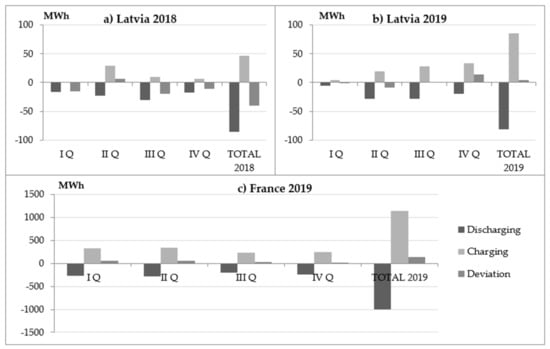
Figure 9.
Scheduled market transactions to restore the SOC.
The dynamics for a certain period of time for BESS active power and state of charge in the case of Latvian power system frequency in 2018 are shown in Figure 10. The total battery power consists of the power provided for the FCR service, as well as all components of the power required for SOC renewal (power of deadband utilisation, FCR overfulfillment, and scheduled market transactions). The SOC of the battery fluctuates on average around the normal setting within the specified limits. When the SOC parameter reaches the set limit of 0.7, the scheduled market transaction is activated with a 1 MW power discharge to the grid for 1 h, thus Figure 10 shows how the operating point of the actual BESS power shifts.
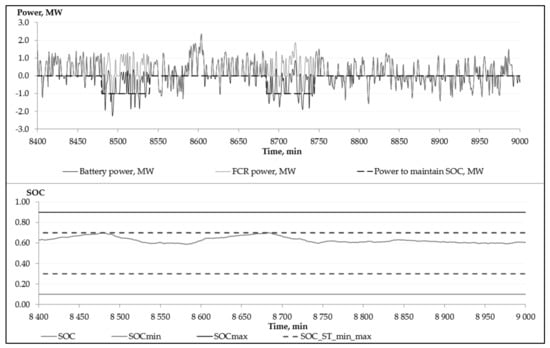
Figure 10.
Dynamics of battery power and state of charge in the example of frequency changes in the Latvian power system in 2018 (I quarter, 06.01.18 at 20:00–07.01.18 at 06:00).
In the example of the French power system, the dynamics of battery power and SOC are shown in Figure 11. Fluctuations of SOC are more frequent, with larger discharge depths, according to frequency fluctuations. Performed SOC management ensures its maintenance within permissible limits.
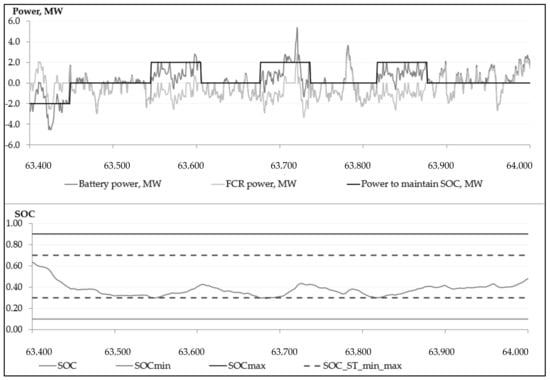
Figure 11.
Dynamics of battery power and state of charge in the example of the French power system (II quarter, 15.05.19 at 00:40–10:40).
In addition, the amount of electricity required to restore the battery’s state of charge at the end of its life cycle has been estimated. Due to the yearly cell degradation, it is assumed that at the end of its technical life, battery capacity has decreased to 80% of its nominal value. There is no uniform trend in the calculation results. For example, in the case of Latvia for the frequency data of 2018, it was necessary to additionally discharge battery for SOC renewal. The surplus electricity sold in the intraday market in this case would account for 40 MWh in the first year of operation and increase to 56 MWh (+40%) in the last. However, analysing the data of 2019, SOC renewal required purchase of an additional amount of electricity from 4 MWh in the first year to 10 MWh (+150%) at the end of the battery life. In the French example, the amount of electricity purchased to renew the SOC at the end of the battery’s life increased by 35% compared to the first year of battery operation. The annual electricity consumption for the entire technical life of the battery for the Latvian and French cases is shown in Figure 12.
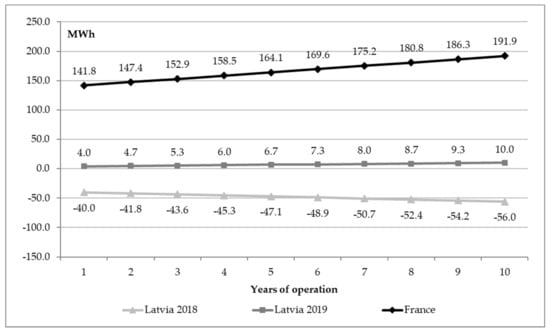
Figure 12.
Annual electricity consumption for SOC renewal during the technical life of BESS.
However, Latvia’s two-year observations (for 2018 and 2019) do not allow reliable predictions to be made about the future costs or income of BESS scheduled transactions. Calculations of BESS operation at the end of its technical life are based on the same frequency fluctuations as in the first year, though frequency dynamics cannot be predicted. It can be assumed that the need to charge BESS will increase due to the cell degradation.
All calculations were performed for specific selected parameters to assess possible BESS operation for the provision of the FCR service, and the possible BESS income and costs. Changing the parameters of the BESS model may change the overall results. In addition, the choice of BESS parameters is influenced by different frequency characteristics in different synchronous zones. In this case, no optimization task was performed to determine the most economically advantageous and technically useful parameters for the battery system.
4. Economic Assumptions
To assess the economic efficiency of the BESS project, authors determined the net present value (NPV) of the project, as well as the internal rate of return (IRR) and the discounted payback period. To assess the capital investments of the BESS project, authors assumed the specific capital costs for energy and for power as 359 EUR/kWh and 445 EUR/kW accordingly. Considering this, the expected capital costs of BESS are estimated at EUR 7.85 million for the example of Latvian power system with 12 MW/7 MWh BESS, and at EUR 8.30 million for the example of French power system with 13 MW/7 MWh BESS. Annual operating expenses amount to 1.5% of the initial investment, or EUR 0.12 million in the Latvian example and EUR 0.13 million in the French example.
Authors also considered additional costs for SOC renewal via scheduled transactions in the intraday market, although the renewal of SOC was not always required to purchase electricity. As can be seen from Figure 12, there was necessity to sell surplus electricity in the intraday market for SOC renewal. However, the amount of additional costs of EUR 6.2 thousand with an annual increase of 3.93% during battery life cycle were assumed in base calculations. The costs are calculated based on the forecasted electricity price (2022 is the start of BESS operation).
In turn, the revenue from the provision of FCR service amounts to EUR 0.95 million annually at the assumed base price of FCR service of 10 EUR/MW per hour. In calculations, the base price of the FCR service is assumed to be the average of the existing FCR service prices in the German and Finnish FCR markets.
Economic calculations assume that continuous provision of FCR service during the contract period is ensured, as well as the right to provide full FCR service yearly–except for two weeks for BESS maintenance–will be won. The discount rate is assumed to be 5.5%.
Considering all the above basic economic assumptions, the BESS project does not pay back during its technical life. The calculated NPV in year 10 for the Latvian example is −1.7 MEUR and IRR 0.64%. The BESS project would require at least 25% co-financing to ensure a payback period of 10 years. In the case of the French energy system, for example, there is correspondingly lower return on investment.
As FCR prices are not predictable, the impact of changes in the price of the FCR service on the payback of the BESS project has been further assessed. FCR price changes are assumed to be ±20% and ±40% of the base price. According to economic calculations, the BESS project can payback within 10 years without additional co-financing, if the price of the FCR service is at least 14 EUR/MW/h. The respective NPV curves for the frequency deviations of the example of the Latvian power system are shown in Figure 13.
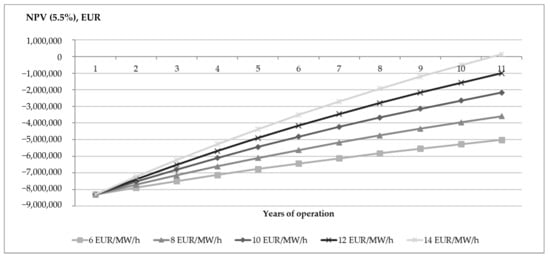
Figure 13.
NPV curves of the BESS project for the example of Latvian power system at different FCR prices.
5. Discussion and Conclusions
Authors evaluated the operation of BESS by developing a mathematical model based on operational principles of the CESA, as well as projections planned by Latvian TSO. The main objective of the research was to observe technical possibilities of a battery energy storage system to provide frequency containment reserves in the Latvian power system after synchronization with CESA.
Comparing the frequency deviations in the Latvian (BRELL) and French (CEN) power systems, the BRELL system has smaller frequency deviations from the nominal value than in the Central European power system. The choice of BESS parameters was influenced by different frequency characteristics in different synchronous zones. Although the BRELL system proved to be more stable, the situation in Latvian power system after desynchronization from BRELL will be quite unique, and the frequency dynamics in the Latvian power system may change. Possible frequency dynamics cannot be predicted; however, authors assume that most likely, higher frequency deviations are expected.
Considering the frequency data of the Latvian power system for 2018 and 2019, the indicative amount for frequency containment reserve could be provided by BESS with at least 11 MW installed power and with a storage capacity of 7 MWh. In addition, 1 MW of installed power should be provided to maintain a normal charge level through planned market transactions. Thus, 12 MW and 7 MWh should be provided in total.
In the event of greater frequency fluctuations, as observed in France in 2019, more power capacity could be required to maintain the SOC level and to ensure continuity of FCR services. The calculations estimated the need for 2 MW of additional power capacity. Thus, the BESS with 13 MW and 7 MWh in total could be installed. However, here the intraday market organisation principles are important. The intraday market in France closes 30 min before the operating hour, while participants in the Latvian intraday market can submit their requests and proposals for transactions on the current day, no later than one hour before the operation hour. One hour for frequency deviations as in the French power system would be too long to keep the SOC levels at permissible limits, and there are risks suspending the provision of FCR. This will require a greater capacity of BESS to keep the provision of FCR until starting the scheduled transaction for SOC renewal.
The BESS project will payback during the technical life of the battery (10 years) as long as the price of the FCR service is at least 14 EUR/MW per hour. At this price, the planned BESS revenue will be EUR 1.32 million per year. However, there are currently no clear forecasts for the future development of FCR service prices. There is currently no FCR market in the Baltic power system, so the costs of the region’s FCR service are difficult to predict. For example, with the introduction of daily auctions, the price of the FCR service in the German market decreased from 14.6 EUR/MW/h in 2017 to 8.7 EUR/MW/h in 2019. The price of the FCR service will be determined by the marginal price of the bids offered in the auction.
All calculations were performed under certain assumptions and under certain selected parameters to assess the possible operation of the BESS for the provision of the FCR service and the potential income and costs of the BESS. Changing the parameters of the BESS model may change the overall results.
In general, in 2025 or after synchronization with the Continental Europe Synchronous Area, it is worth to consider battery electric storage systems as alternative equipment to provide sufficient levels of frequency containment reserves. Feasibility study may discover that for viability reasons it is necessary to maintain an option to use the BESS, as well as for other ancillary services.
Author Contributions
The contributions of the authors to this paper are as follows: methodology and simulation S.K. and E.G., conceptualization and writing-original draft preparation E.G., data curation O.L. and K.G. All authors have participated in formal analysis, writing-review and editing. All authors have read and agreed to the published version of the manuscript.
Funding
This work has been supported by the European Social Fund within the Project No 8.2.2.0/20/I/008 «Strengthening of PhD students and academic personnel of Riga Technical University and BA School of Business and Finance in the strategic fields of specialization» of the Specific Objective 8.2.2 «To Strengthen Academic Staff of Higher Education Institutions in Strategic Specialization Areas» of the Operational Programme «Growth and Employment».
Institutional Review Board Statement
Not applicable.
Informed Consent Statement
Not applicable.
Data Availability Statement
Latvian power systems frequency deviation data are not publicly accessible and are not disclosed in this publication. Data source on French power system is found in French transmission systems operators RTE webpage [19].
Acknowledgments
The research has been supported by AS “Latvenergo”. Frequency data has been supplied by the AS “Augstsprieguma tīkls”. The team would like to acknowledge the researchers from Riga Technical University Institute of Power Engineering for valuable advice.
Conflicts of Interest
The authors declare no conflict of interest. The publication consists of algorithm, technical calculation, and open methodology for calculating technical parameters.
Nomenclature
| ∆f | Deviation of actual frequency f from the nominal frequency |
| ∆fmax | Maximal frequency deviation at which total prequalified FCR power should be activated |
| ∆t | Time moment of 1 min in the studied case |
| aFRR | Automatic frequency restoration reserve |
| BESS | Battery electric storage system |
| BRELL | Belarus, Russia, Estonia, Latvia, Lithuania |
| CAES | Compressed Air Energy Storage |
| CEN | Continental European Network |
| CESA | Continental Europe Synchronous Area |
| DODmax | The coefficient of maximum depth of discharge |
| EBESS_fact | Actual available capacity of the battery |
| EBESS_nom | Nominal battery electrical capacity |
| ESS | Energy storage systems |
| f | Actual frequency |
| FCR | Frequency containment reserve |
| fnom | Nominal frequency f = 50 Hz |
| FRR | Frequency restoration reserve |
| mFRR | Manual frequency restoration reserve |
| PBESS(t) | Battery power at time moment t |
| PFCR(t) | Actual necessary positive or negative power for FCR provision according to frequency deviation |
| PFCR_max | Maximal FCR power |
| PHES | Pumped hydro stations |
| PST | Planned transaction capacity |
| RR | Replacement reserve |
| SMES | Superconducting Magnetic Energy Storage (SMES) |
| SOC | State of charge |
| SOC(t) | The state of charge of the battery at time moment t |
| SOC(t−1) | State of charge at previous time moment |
| SOCmax | Maximum SOC |
| SOCmin | Minimum SOC |
| SOCnorm | Normal state of charge |
| SOCOF_max | Maximum state of charge for activation of FCR overfulfillment |
| SOCOF_min | Minimum state of charge for activation of FCR overfulfillment |
| SOCST_max | Maximum state of charge for activation of scheduled transaction |
| SOCST_min | Minimum state of charge for activation of scheduled transaction |
| TSO | Transmission system operators |
| tST | Duration of scheduled transaction |
| UPS | Russian United Power System |
| ηBESS | Round-trip efficiency of battery storage system |
References
- Sauhats, A.; Utans, A.; Silinevics, J.; Junghans, G.; Guzs, D. Enhancing Power System Frequency with a Novel Load Shedding Method Including Monitoring of Synchronous Condensers’ Power Injections. Energies 2021, 14, 1490. [Google Scholar] [CrossRef]
- Tuohy, E.; Bulakh, A.; Tsarik, Y.; Tuohy, E.; Bulakh, A. Desynch or Sink Title: Desynch or Sink—A Political Analysis of Baltic Electricity Desynchronization. 2017. Available online: www.icds.ee (accessed on 17 February 2022).
- AS Augstsprieguma Tīkls; Elering AS; LITGRID AB. Memorandum of Understanding on Development of the Baltic Load-Frequency Control Block; AS Augstsprieguma tīkls: Riga, Latvia; Elering AS: Tallinn, Estonia; LITGRID AB: Vilnius, Lithuania, 2020. [Google Scholar]
- Siemens. A Stable Grid in the Era of Renewables. Available online: https://www.siemens-energy.com/global/en/offerings/power-transmission/portfolio/flexible-ac-transmission-systems/synchronous-condenser.html (accessed on 12 April 2021).
- Robb, A. Grid Inertia: Why It Matters in a Renewable World. 2019, pp. 1–5. Available online: https://www.renewableenergyworld.com/baseload/grid-inertia-why-it-matters-in-a-renewable-world/#gref (accessed on 12 April 2021).
- Augstprieguma Tīkls. Pārvades Sistēmas Operatora Ikgadējais Novērtējuma Ziņojums par 2019. Gadu. Riga. 2020. Available online: https://www.ast.lv/sites/default/files/editor/PSO_Zinojums_2019.pdf (accessed on 12 April 2021).
- Hartmann, B.; Vokony, I.; Táczi, I. Effects of decreasing synchronous inertia on power system dynamics—Overview of recent experiences and marketisation of services. Int. Trans. Electr. Energy Syst. 2019, 29, e12128. [Google Scholar] [CrossRef] [Green Version]
- Memorandum of Understanding among ECA, PUC, NCC, URE Concerning the Process of the Synchronization of the Baltic States Electricity System with the Continental Europe Networks. 13 May 2019. Available online: https://www.sprk.gov.lv/sites/default/files/editor/MoU_Synchro_0.pdf (accessed on 7 June 2021).
- Kronenbergs, I.; Kutjuns, A.; Karpoviča, I.; Ertmanis, K.; Sīlis, A.; Bāliņš, A. Tirgotāju Brokastis 22|11|2019| Teikums. Riga. November 2019. Available online: https://www.ast.lv/lv/events/seminars (accessed on 12 April 2021).
- Junghans, G.; Silis, A.; Marcina, K.; Ertmanis, K. Role of Balancing Markets in Dealing with Future Challenges of System Adequacy Caused by Energy Transmission. Latv. J. Phys. Tech. Sci. 2020, 57, 48–56. [Google Scholar] [CrossRef]
- European Association for Storage of Energy. EASE Task Force 2.6 Segmentation of Applications. In Energy Storage Applications Summary; European Association for Storage of Energy: Brussels, Belgium, 2019; Available online: https://ease-storage.eu/wp-content/uploads/2020/06/ES-Applications-Summary.pdf (accessed on 17 February 2022).
- Deloitte. Energy Storage: Tracking the Technologies That Will Transform the Power Sector. Available online: https://www2.deloitte.com/content/dam/Deloitte/no/Documents/energy-resources/energy-storage-tracking-technologies-transform-power-sector.pdf (accessed on 17 February 2022).
- Stroe, D.I.; Knap, V.; Swierczynski, M.; Stroe, A.I.; Teodorescu, R. Suggested operation of grid-connected lithium-ion battery energy storage system for primary frequency regulation: Lifetime perspective. In Proceedings of the 2015 IEEE Energy Conversion Congress and Exposition (ECCE), Montreal, QC, Canada, 20–24 September 2015; pp. 1105–1111. [Google Scholar] [CrossRef] [Green Version]
- Thorbergsson, E.; Knap, V.; Swierczynski, M.; Stroe, D.; Teodorescu, R. Primary frequency regulation with li-ion battery based energy storage system—Evaluation and comparison of different control strategies. In Proceedings of the INTELEC, International Telecommunications Energy Conference, Hamburg, Germany, 13–17 October 2013; Available online: https://ieeexplore.ieee.org/document/6663276 (accessed on 17 February 2022).
- Thien, T.; Schweer, D.; vom Stein, D.; Moser, A.; Sauer, D.U. Real-world operating strategy and sensitivity analysis of frequency containment reserve provision with battery energy storage systems in the german market. J. Energy Storage 2017, 13, 143–163. [Google Scholar] [CrossRef]
- Jomaux, J.; Latiers, A.; de Jaeger, E. Cost-based dimensioning of Battery Energy Storage and energy management system for Frequency Containment Reserves provision. In Proceedings of the IEEE Power and Energy Society General Meeting, Denver, CO, USA, 28–30 July 2015. [Google Scholar] [CrossRef]
- Filippa, A.; Hashemi, S.; Traholt, C. Economic Evaluation of Frequency Reserve Provision using Battery Energy Storage. In Proceedings of the 2019 IEEE 2nd International Conference on Renewable Energy and Power Engineering (REPE 2019), Toronto, ON, Canada, 2–4 November 2019; pp. 160–165. [Google Scholar] [CrossRef]
- Maucher, P.; Lens, H. On the specification of requirements for the activation dynamics of Frequency Containment Reserves. In Proceedings of the 2021 IEEE International Conference on Communications, Control, and Computing Technologies for Smart Grids, SmartGridComm 2021, Aachen, Germany,, 25–28 October 2021; pp. 45–50. [Google Scholar] [CrossRef]
- Shafique, H.; Tjernberg, L.B.; Archer, D.E.; Wingstedt, S. Energy Management System (EMS) of Battery Energy Storage System (BESS)—Providing Ancillary Services. In Proceedings of the 2021 IEEE Madrid PowerTech, PowerTech 2021—Conference Proceedings, Madrid, Spain, 27 June–2 July 2021. [Google Scholar] [CrossRef]
- REGELLEISTUNG. Internetplattform zur Vergabe von Regelleistung. 2019. Available online: https://www.regelleistung.net/ext/?lang=en (accessed on 12 April 2021).
- Fleer, J.; Stenzel, P. Impact analysis of different operation strategies for battery energy storage systems providing primary control reserve. J. Energy Storage 2016, 8, 320–338. [Google Scholar] [CrossRef]
- RTE. RTE—Services Systèmes. Available online: http://clients.rte-france.com/lang/an/visiteurs/vie/telecharge_details.jsp?data66=on (accessed on 12 April 2021).
- Zablocki, A. Energy Storage; Environmental and Energy Study Institute: Washington, DC, USA, 2019; Available online: https://www.eesi.org/papers/view/energy-storage-2019 (accessed on 17 February 2022).
Publisher’s Note: MDPI stays neutral with regard to jurisdictional claims in published maps and institutional affiliations. |
© 2022 by the authors. Licensee MDPI, Basel, Switzerland. This article is an open access article distributed under the terms and conditions of the Creative Commons Attribution (CC BY) license (https://creativecommons.org/licenses/by/4.0/).